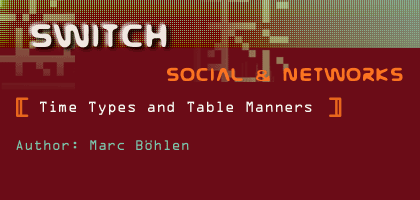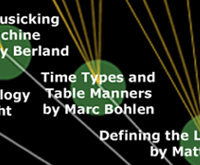 |
 |
 |
 |
 [ larger version, 36k JPEG ] [ larger version, 36k JPEG ]
This article will discuss, using the collaborative project DinnerTable [1] as a guideline, notions of time, information manipulation and social entanglement in electronic art. DinnerTable is an interactive experience machine that mimics a game of life and creates scenarios for a cast of characters in an anonymous urban setting. It is a table, a machine and a game simultaneously. DinnerTable lives in a restaurant setting and feeds in this intimate interface between the private and public on external stimuli collected through speech recognition and a vision system. Visual and audio inputs are used to direct the paths of a narrative engine that spins off narrative tracks, enacted on the game board by game board figures and made understandable to users in text, motion and imagery [2]. Prototype of DinnerTable in a Laboratory Setting There are three paths along which this work integrates itself into a user's experience. These paths are Situation, Duration and Participation. Situation. In its final version DinnerTable will be placed in the highly coded social setting of the restaurant. Thus it becomes an attachment to the framework of the restaurant experience and works as an event specific installation. The restaurant is a strongly typed social environment with known etiquette. The dining tradition is a well-defined ritual. It is delicately variable in its details yet rigid in the sequence of events. Quests expect to be served and are often happy to accept recommendations from the Maître de service. Dining adheres to formalized protocols; table manners and lack thereof are an integral part of the dining experience. DinnerTable functions in this structured but noisy setting as a commentator on unfolding events, a generator of stories and a passive onlooker. It is an uninvited quest but adheres to the codes of discreteness and exchange. It entangles itself into the dinner event and becomes oddly inspiring or obnoxiously intrusive. Duration. Just as information can be efficiently encoded in dedicated data types, time can be more appropriately described in select time types. The rational for addressing this issue here is given by the fact that DinnerTable actively employs multiple notions of time to engage the users or to unobtrusively fall into quiet background mode. The idea of distinguishing typologies of time is not new. Bergson, for one, emphasized a duality of time. Starting from the Bergsonian notion of a distinction between quantitative discrete time and qualitative time-duration [3] we add a third vector, that of machinic time. The resulting categories are as follows. Oscillatory Time: This is discrete time in its purest form. It is the time form of scientific abstraction and formalization. It is the first principle of the quantitative time concept. Oscillatory time is embodied in but not equivalent to the periodic swing of the crystal quartz and atomic clocks [4]. It is the notion of time that has enabled continued increases in processor speeds for computation devices in the last decades. Oscillatory time is cut and dry, arbitrarily fast [5] and invariant in its repeatable precision. It is always maximum fast and is active (today) in realms beyond those of human perception. Machinic Time: This time type is derived from oscillatory time but expands the first category into concrete applications. Machinic time is the task-based time of machinic execution. This can be as fundamental as the transistor's move from a high to a low output. Machinic time shows itself in the switching of a relay, the updating of a CRT screen or the meshing of gears in a gear train. This is the time type of loading variables into memory and of algorithm execution. Machinic time spans a large range, from microseconds to seconds into the timeframe perceivable by human beings. It takes the guise of the electrical, electro-mechanical, mechanical and biochemical [6]. It is variable and open to design preferences. Machinic time is the time type scientists and engineers operate in when optimizing time resources. Furthermore, machinic time is the lowest order time type accessible to and modifiable in the electronic arts. Artists work in the machinic time domain when they build a sensor that reacts to the touch of the user, when they chose to dissolve an image before loading a next one, when they design motors to move almost imperceptibly slow, or when they add delays to an algorithm to ensure a particular behavior of a machine does not evade a user's attention. Inversely, machinic time is employed when an algorithm is optimized to prevent its (graphic) output from appearing awkwardly delayed. Machinic time is an essential element in the toolbox of today's electronic artists. Machinic time is the interface to the intangible domain of the third time vector. Perceptual Time: This is the time domain Bergson [7] coined qualitative time. Perceptual time is both a function of the possibilities and limitations of our sensory organs as well as an intangible notion of multiplicity of conscious states. As such it is the antithesis of oscillatory time. It is a prolongation of the past into the future. It is duration. It is, as a time type, an intuitive measure and defies quantitative description. In sleep we live, by Bergson, pure duration. Through the idea of duration, perceptual time includes the notion of impatience. While it is culturally encoded perceptual time is a time type all human beings experience. It is the time domain in which human beings can return to an irrational state. It is the time type in which a work of art is appreciated. It includes the dwelling and delay necessary to appreciate complexity or the mind space of another human being. Perceptual time can not be manufactured as machinic time can. However, it can be enabled. Hakim Bey's idea of T.A.Z., a temporary autonomous zone [8], can be understood as such a perceptual time enabling circumstance. Through the intertwining of the narrative track with events occurring around the table, food, drink the motion of the figures sliding across the board and the synchronized display of imagery, DinnerTable plays with and fosters the experience of perceptual time. Participation. DinnerTable is a knowledge acquisition machine. It collects audio and visual data from the dinner episode and uses this information to situate itself in between its users. By virtue of its event specificity it can make recourse to the knowledge base on dinner ritual and use it to disambiguate data. Physically and functionally it meshes into the exchange between the guests and their activities. It is both the connecting link as well as a barrier between two dinner companions. Just as human beings distinguish between an intrusive stare and an attentive observation, surveillance technologies can manipulatively collect or selectively filter data (and discard results). DinnerTable employs traditional surveillance technology in an unorthodox fashion. All collected data is fed back into the experience system in a closed loop form. The closed loop observations are transformed and returned, reflected back to the user in the form of narratives spun by the table over the course of an evening spent with the machine. There is a cold form of intimacy that can evolve from this type of exchange. It is akin to the emotionally distant but attentively listening sympathetic stranger. The present states of speech recognition and image analysis limit the sophistication of the knowledge that can be collected by our machinic table. It is conceivable that the future will allow us to create artworks that can fully and kindly participate in sophisticated forms of social exchange. The result could be called knowledge-based intimacy. DinnerTable is, in this regard, an anticipation of things to come. While the idea of knowledge-based intimacy generates anxiety in many people today, appreciation thereof may become an acquired taste in the future. [1] DinnerTable is the result of a collaborative effort between Beth Monoian, Michael Mateas and Marc Böhlen. A first work in progress report was presented at the Digital Secrets Symposium at Arizona State University in November 2000. [2] For a more detailed description see: http://www.acsu.buffalo.edu/~mrbohlen/dinnerTable.htm [3] Henri Bergson, Essai Sur Les Données Immédiates De La Conscience, 1889 and Evolution Créatrice, 1907. [4] Quantum theory postulates that atoms can only exist in certain discrete energy states depending on which orbits about their nuclei are occupied by electrons. Atomic-beam clocks utilize discrete transitions in the electron energy levels of the lowest set of orbits. For example, a cesium-beam atomic clock is a device that uses as a reference the exact frequency emitted by atoms of the metallic element cesium, in particular its isotope Cs-133 when exposed to microwaves. The frequency produced is a function of the energy absorbed from the incident photons when they excite the outermost electron to transition from a lower to a higher orbit. The integral of frequency is time, so this frequency, 9,192,631,770 hertz (Hz = cycles/second), provides the fundamental unit of oscillatory event space. See National Institute of Standards and Technology (NIST), The Time and Frequency Division, http://www.boulder.nist.gov/timefreq/general/precision.htm [5] The present state-of-the-art in consumer fare desktop computers contain processors running at 1.5Ghz. Intel claims that the doubling of processor speeds every 18 to 24 months (Moore's Law) will continue to hold and result in clock rates exceeding 10Ghz within a decade. See IEDM, 2000 International Electron Devices Meeting, http://www.his.com/~iedm/ [6] The (mammalian) circadian clock system, the governing of 24-hour oscillations in behavior, physiology, and biochemistry, can be interpreted, in this framework as a biological form of machinic time. Recent research suggests that circadian time is a highly variable clock type. See: Gekakis, N., D. Staknis, H.B. Nguyen, F.C. Davis, L.D. Wilsbacher, D.P. King, J.S. Takahashi and C.J. Weitz. 1998. Role of the CLOCK protein in the mammalian circadian mechanism. Science 280:1564-1569. [7] For a more detailed appreciation of Bergon's ideas and their relevance to critical theory see: Gilles Deleuze, Le Bergsonisme, Presses Universitaires de France, 1966. [8] Hakim Bey, T.A.Z, The Temporary Autonomous Zone Ontological Anarchy and Poetic Terrorism, Autonomedia, 1985. ================== Marc Böhlen is a new media artist with a formal background in Art History, Electrical Engineering, Robotics, Stone Masonry and Fine Arts. He has worked in Optoelectronics with IBM Research Laboratories and JDS-Uniphase. His work centers on subjectification of advanced technologies, with applications in Contemplative Robotics, Animal Machine Interaction and Kind Surveillance. He has shown work and lectured in Switzerland, France, Germany, Italy, Portugal, Spain, and the USA. Recent activities include teaching appointments at the University of California at San Diego, a fellowship at the Center for Research in Computing and the Arts (CRCA) San Diego, and research on interactive robotics with Probotics Inc. in Pittsburgh. Böhlen is now Assistant Professor at the Media Studies Department at SUNY Buffalo. His selected group exhibitions include: Advanced Perception, Associated Artists of Pittsburgh Gallery, Pittsburgh, 1999; Office Plant #2, Annual Digital Salon, New York, Barcelona, Rome, 1999; Petty Philosopher, Carnegie Science Center, Pittsburgh, 1999; Office Plant #1, American Association for Artificial Intelligence (AAAI) Conference, Madison, 1998; Orlando II, Hewlett Gallery, Pittsburgh, 1998; Friendly Fiction, Rhizome, Mainframe of the Sorbonne, Paris, 1997; and Attack, Frauenbuchladen, Zurich, 1995. |